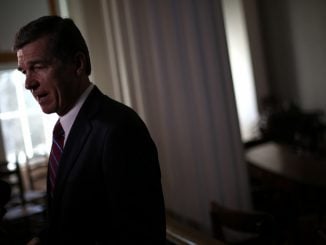BEDMINSTER, N.J. — President Donald Trump bypassed the nation’s lawmakers to defer payroll taxes and replace an expired unemployment benefit with a lower amount after negotiations with Congress on a new coronavirus rescue package collapsed.
Trump’s executive actions seem likely to be met with legal challenges. The president cast his actions as necessary given that lawmakers have been unable to reach an agreement to on an economic package.
Trump moved to continue paying a supplemental federal unemployment benefit for millions of Americans out of work during the outbreak. The action calls for up to $400 payments each week, one-third less than the $600 people had been receiving. How many people would receive the benefit and how long it might take to arrive were open questions.
The previous unemployment benefit, which expired at the end of July, was fully funded by Washington, but Trump is asking states to now cover 25%. He is seeking to set aside $44 billion in previously approved disaster aid to help states, but said it would be up to states to determine how much, if any of it, to fund.
Trump hopes the four executive actions he signed will signal to Americans that he is acting where Congress will not to address economic fallout from the COVID-19 pandemic.
Trump’s embrace of executive actions to sidestep Congress ran in sharp contrast to his criticism of former President Barack Obama’s use of executive orders on a more limited basis. Though Trump cast it as a necessary step given the deterioration of congressional negotiations.
In addition to the extension of some unemployment benefits, Trump’s orders call for a deferral of payroll tax and federal student loan payments and efforts to halt evictions. The evictions executive order directs the Treasury and Housing and Urban Development departments to identify funds to provide financial assistance to those struggling to pay their monthly rent.
Trump said the employee portion of the payroll tax would be deferred from Aug. 1 through the end of the year. The move would not directly aid unemployed workers, who do not pay the tax when they are jobless, and employees would need to repay the federal government eventually without an act of Congress.
In essence, the deferral is an interest-free loan that would have to be repaid. Trump said he’ll try to get lawmakers to extend it, and the timing would line up with a post-election lame-duck session in which Congress will try to pass government funding bills.
“If I win, I may extend and terminate,” Trump said, repeating a longtime goal but remaining silent on how he’d fund the Medicare and Social Security benefits that the 7% tax on employee income covers. Employers also pay 7.65% of their payrolls into the funds.
Senate Majority Leader Mitch McConnell, R-Ky., issued a statement saying he supported Trump “exploring his options to get unemployment benefits and other relief to the people who need them the most.” Like Trump, McConnell accused Democrats of using the coronavirus package negotiations to pursue other goals.
With no deal on virus relief in sight, lawmakers went home on Friday with instructions to be ready to return for a vote on an agreement. A stalemate that could stretch well into August and even September was possible, casting doubt on the ability of the Trump administration and Democrats to come together on a fifth COVID-19 response bill.
The four executive actions cover the following:
UNEMPLOYMENT INSURANCE
The president’s action called for payments up to $400 each week, less than the $600 people had been receiving under a benefit that expired last month.
How many people will receive the benefit and for how long is open to question. Trump said the payments would be funded 75% by the federal government and 25% by states. But it is unclear if states will pay that share. The federal government had been covering the full cost of the now-expired $600 supplement.
Ariel Zetlin-Jones, associate professor of economics at Carnegie Mellon University’s Tepper School of Business, said several states have already depleted their unemployment compensation trust funds and have requested federal loans to keep making payments. Trump’s order, he said, is likely to exacerbate the debt burden for states and prove costlier in the long term because state governments borrow at higher costs than the federal government.
“This higher debt burden is one reason governors may resist enacting at least their share of $400 promised in the executive order,” Zetlin-Jones said.
The Trump administration is setting aside $44 billion from the Disaster Relief Fund to pay for the extra jobless benefits. Under the order, the payments will last through Dec. 6 — or until the disaster fund’s balance falls to $25 billion. With hurricane season now underway, the fund currently has a balance of about $70 billion.
PAYROLL TAX DEFERRAL
Under the president’s action, employers can defer collecting the employee portion of the payroll tax, including the 6.2% Social Security tax on wages, effective Aug. 1 through the end of the year. The order is intended to increase take home pay for employees making less than about $100,000 a year. White House economic adviser Larry Kudlow estimated Sunday that the payroll tax deferral could save employees about $1,200 through the end of the year.
However, employees would need to repay the federal government eventually without an act of Congress. Consequently, many employers may choose to continue collecting the tax and set it aside to meet that future obligation, said Michael Graetz, a Columbia University law professor and co-author of “The Wolf at the Door: The Menace of Economic Insecurity and How to Fight It.”
Trump is proposing that Congress pass a permanent payroll tax cut, but the prospects of such a measure is uncertain. Democrats and some Republicans are against any change to the payroll tax because it could deplete the Social Security and Medicare Trust funds.
Both programs were already in dire condition before the pandemic, with Medicare expected to become insolvent in six years and Social Security unable to pay full benefits starting in 2035. Those government projections came before millions of taxpayers were thrown out of work.
EVICTION CRISIS
The president directed the Treasury and Housing and Urban Development departments to identify funds to provide aid to those struggling to pay their monthly rent. He also directed HUD to take action to “promote the ability of renters and homeowners to avoid eviction or foreclosure.”
In an appearance on CNN on Sunday, Kudlow said the order gives the housing authority wide power to stop evictions, for instance by citing the risk of COVID-19 spread in a community.
It’s unclear how much immediate relief the order will provide tens of millions of people at risk of being evicted over the next months. Around 30 state moratoriums have expired since May. The Aspen Institute has estimated that 23 million renters are at risk of eviction by Sept. 30.
STUDENT LOANS
Trump’s executive action extended a moratorium on student loans backed the federal government, which was initially passed by Congress and would have expired on Sept. 30. The moratorium also forgave interest on the deferred payments.
The order does not cover loans from private lenders since the government would have repay those providers and the president lacks the authority to direct funds for such a purpose.



